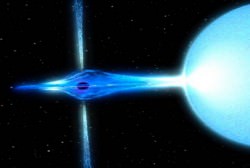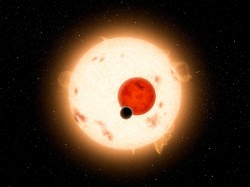We’re familiar with the sky on Tatooine with its twin suns. But could a planet actually orbit two stars at the same time? Could you have a planet in a multiple star system with 4, 6 or more suns?
Hey kids, you remember Star Wars right? Tatooine ring any bells? Lots of sand Tusken raiders walking single file. Banthas sweating all over the place like some crazy mammoth-goat breeding experiment gone horribly awry?
Tatooine was an arid desert planet, it had 2 suns and 3 moons. It’s not the only fictional planet to orbit multiple suns. In Nightfall by Isaac Asimov, planet Lagash had 6 suns. Could something like this be possible?
Interestingly, most stars in the Milky Way are in multiple star systems. You can easily have double, triple, or quadruple systems. There are even star clusters with hundreds or even thousands of stars. Just imagine the crazy chaotic gravitational interactions in a multiple star system.
So, could they have planets? Yes. There are circumbinary systems, where stars orbit each other their planets orbit outside, circling them both. Since the stars orbit one another so closely, it’s the gravitational equivalent of a single star. From an orbiting planet, the stars would always appear together in the sky.
To date, we have discovered 17 of these systems. Then there are wide binary systems, which are far more dangerous for planets. Here the planets orbit one main star, and there’s another star which maintains a distant orbit much further out. You don’t want to live there. The gravitational interactions are chaotic and lead to mayhem. In simulations, planets which aren’t tightly orbiting a star are ejected out of the system, or crashed into other planets or stars.

We might already be detecting highly elliptical orbits from disrupted planets just like these. A triple star system was recently discovered in the constellation Cygnus: HD 188753. Here, a pair of stars are tightly bound, and these are in a wide binary arrangement with a sun-mass star. A planet closely orbits the primary star, but all other planets were likely ejected.
In the year 2012, a planet was found around Alpha Centauri B, and PH1 was the first quadruple star system to be discovered to have a planet. Kepler 47 is a multi-star, multi-planet system. Two stars orbit one another every 7.45 days. Here, the gas giant Kepler 47c orbits the stars every 303 days and is even located in the habitable zone. This sounds like perfect concept art for a Vin Diesel film, or artwork airbrushed on the side of a van.

Finally, In 2011, the Kepler-16 system was found to have a circumbinary planet in the habitable zone. So, two stars, closely orbiting each other and a Saturn-mass, Kepler 16b orbiting the two. Astronomers informally called this a real Tatooine.
What do you think? Would you want to live on a desert world like Tatooine or Arrakis? Tell us your thoughts in the comments below.


The “planet” around Alpha Centauri B has yet to be confirmed with independent observations failing to find the evidence. TBD.
Love the thoughts of planets in multiple star systems. Imagine sunsets on a habitable zone planet orbiting a close pair. First one sun sets, then the other. Night falls only to be lit by another member or pair of the stellar system perhaps 10s of AU distant still brighter than the full moon, well for half the year anyway.